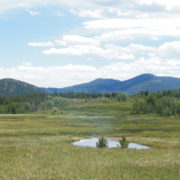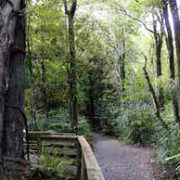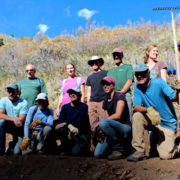Citizens Saving Vanishing Vistas: Colorado Open Lands
by Vicky Gits
“Colorado Open Lands was an experiment. It was the incorporation of a citizens effort to save what Coloradans love about Colorado,” wrote former Gov. Richard Lamm (1975 to 1987) in an introduction to COL’s 30th anniversary report in 2011.
|
Colorado Open Lands Location: Lakewood Year founded: 1982 Executive director: Tony Caligiuri Conservation easements in Jefferson County: 6 Acres preserved in Jefferson County: 1,903 Total conservation easements: 297 Total acres statewide in conservation easements: 267,687 in 40 counties |
A statewide land trust based in Lakewood since 1982, Colorado Open Lands is an outgrowth of the 1980 Colorado Front Range Project, a citizens group created by then-Gov. Lamm to help shape the state’s future.
In 1982, Colorado Open Lands helped prevent the 3,200-acre Evans Ranch at the foot of Mount Evans in Clear Creek County from becoming a subdivision with hundreds of homes. With the help of a loan from the Gates Family Foundation, COL purchased the land, which was strategically divided into five lots, preserving the bulk of the property.
As of 2015, the nonprofit had 267,687 acres in its portfolio of conservation easements. Conservation easements enable private owners to use their land while agreeing to maintain it in a natural state and forgo real estate development. The landowner receives significant state and federal tax advantages for having donated or sold the easement and the land remains private. The conservation easement “runs with the land,” meaning it applies to present and future owners.
In connection with holding conservation easements, land trusts are responsible for stewardship of the related land, which includes inspecting it on an annual basis and verifying it is being maintained according to the terms of the easement agreement.
Passing the torch
Dan Pike, the former president and CEO of Colorado Open Lands, retired late last year after 17 years.
“Dan Pike has been an iconic leader in the land conservation industry both in Colorado and the national stage,” said Tony Caligiuri, president and CEO, who joined the organization in November from the National Wildlife Federation where he was senior vice president for conservation and education. “Pike was a leader in building Colorado’s first statewide land conservation organization into an organization of national stature,” Caligiuri said.
In 2004, Pike secured the conservation easement on 80,000 acres of the Trinchera Ranch in Costilla County, marking the largest such easement in Colorado history. Now owned by investor Louis Bacon, Trinchera previously was owned by Malcolm Forbes, who set up the conservation easement in 2004.
Pike also chaired the commission that helped establish the parameters for certifying land trusts that hold conservation easements where the state tax credit is used.
In June 2013, COL announced another major achievement with conservation easements on 21,000 acres of Louis Bacon’s Tercio and Red River ranches near Trinidad in southern Colorado.
Pike also initiated outdoor excursions, fishing opportunities and farm-products access to help connect people to conservation lands.
Growth impacts
Caligiuri said current conditions are somewhat less favorable to conservation efforts. “We are currently in a period of economic growth which can impact land values and diminish the ability of land trusts to conserve important landscapes. At the same time, many land trusts established in previous decades are evaluating their own capacity to steward land in perpetuity and the wisdom of too many organizations doing similar work. This is prompting some exciting conversations about partnerships and innovative evolution of the land conservation industry, which should help strengthen the outlook for the future,” Caligiuri said.
While continuing to pursue conservation easements, COL has launched a pioneering program to connect people to conserved land. The Conserved Colorado initiative allows buyers to purchase items such as beef, wine and family vacations, from people who have chosen to permanently conserve their land.
“Conserved Colorado allows people to support conservation through their buying power, and creates an additional incentive for property owners looking at the potential benefits of conserving their land,” Caligiuri said.
COL is certified by the state Conservation Easement Oversight Commission and also accredited by the national Land Trust Alliance. Colorado requires that all easement holders be certified by the state under a law signed by Gov. Bill Ritter in 2008 in order for donors to receive the tax credit.
COL in Jefferson County
Conservation easements: 6
Total acres: 1,903
Bear Tooth Ranch – North Hogback Valley
Heine Wildlife Sanctuary – Wheat Ridge
Indian Hills
Knoebel (B Bar K) South turkey Creek
Mirador Ranch – North Mountains
Williams Wildlife Preserve (Five Fridges Farm) – Wheat Ridge
A few of COL’s successes are:
Trinchera Ranch, 80,000 acres, 2004.Costilla, County, San Luis Valley. Malcolm Forbes- donated conservation easement, largest conservation easement in Colorado history.
Pine Cliff Ranch, Douglas County, 3,400 acres. Donated by Sedalia resident James Rathbone Falck for protection in 1986.
Heil Valley Ranch, 1,200 acres. Now part of Boulder County’s North Foothills Open Space, Heil Valley Ranch was a conservation easement to ensure the protection of County-owned open space purchased using Great Outdoors Colorado funds.
Wahatoya Valley, 1,019 acres, late 90s. Spanish Peaks area.
Wahl-Coleman Ranch, Park County, 3,600 acres, 1999. Protects iconic gateway views from Kenosha Pass.
Heron Pond Natural Area, 46 acres. South Platte River Greenway.
Allis Ranch Preserve, Douglas County, 830 acres. 1.5 miles of West Plum Creek.
Bar K Ranch III, Gunnison County, 480 acres.
Mission statement: “Our mission is to preserve the significant open lands and diminishing natural heritage of Colorado through private and public partnerships, innovative land conservation techniques and strategic leadership while bringing a statewide perspective based on our staff’s collective 100-plus years of experience.”


















